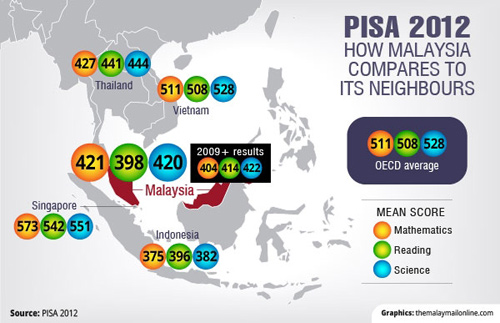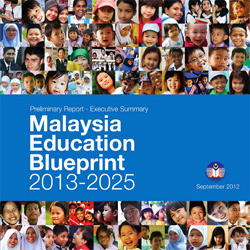The year 2013 ended on a low note for education when the World Bank made a blunt assessment of the state of Malaysia's public education system.
The December report - Malaysia Economic Monitor: High Performing Education - revealed that the quality of education puts does not bode well for achieving high income status by 2020.
Why is the World Bank report significant? Because they are number crunch-ers and it's hard to argue with cold hard facts. Trailing behind poorer East Asian countries
Trailing behind other East Asian countries

Perhaps one of the most shocking points is that not only are we trailing behind high-performing education systems in East Asia, we also lagged behind lower-income countries like Vietnam by a significant margin.
Among East Asian countries that participate in the Programme for Interna-tional Student Assessment (PISA), which compares the math, reading and science skills of secondary school students around the world, Malaysian students lagged far behind their peers in Singapore, who placed second behind top-scorers in Shanghai, China, as well as 15-year-olds in Thailand.
And the news doesn't get better. We continue to slide in the Trends in Inter-national Mathematics and Science Study (TIMSS) benchmark. Where Malaysia's results were “above the international average” between 1999 and 2003, it “declined sharply in 2007 and further in 2011.”
“The quality of cognitive skills of Malaysian students, as measured by stand-ardized international tests, is not on par with the country's aspirations to become a high-income economy, “ said the Report.
Big education budget, yet poor results
The Ministry of Education's Preliminary Report on the Malaysia Education Blueprint 2013-2025 notes that since Independence, the Education Ministry has consistently received one of the highest budget allocations.
In 2011, Malaysia spent the equivalent of 3.8 per cent of its gross domestic product on education, or more than twice the average 1.8 per cent within ASEAN nations.
There is no doubt that we have had our share of admirable results. In 2011, Malaysia had achieved near universal enrolment at the primary level at 94%. Youth literacy has risen from 88% in 1980 to near-universal literacy of 99% today.
But at a time when our neighbours are racing ahead, and we are being left behind, we cannot afford to bury our heads in the sand.
Every year we are told the number of students in UPSR and SPM are getting more and more A's, yet when we are compared against others in our own neighbourhood a different story emerges.
Examination results are concealed under the Official Secrets Act so no one really knows where the discrepancy occurs. As with any health diagnosis, would we tolerate the doctor not showing us our test results so that we know exactly where the problem is and what we need to change?
From conform to transform

The World Bank noted that Malaysian Education Blueprint 2013-2025 contained a progression towards a school-based management system that would encourage greater autonomy, although it noted a “lack of specificity about how such a system would operate.”
That the specifics are lacking is worrying to parents, educators and employers. While the Blueprint says all the right things and it's mission is undoubtedly sincere, are we not going to be hobbled without specifics and benchmarks?
The reality is that we have an entrenched system of conformity which we have unfortunately equated to being of Asian descent. Too much of education remains about fitting in, rather than standing out. When we insist on conformity, we breed mediocrity. After 12 years of conformity, we've pretty much put the minds of our children in a deep freeze.
Perhaps the most depressing news out of the Report is that a whopping 93 per cent of those applying for the Bachelor of Education programme did not have the necessary academic qualifications (3 distinctions or more at SPM level), while 70 per cent offered a place in the programme also fell into the category.
Only 3 per cent of offers went to applicants considered high-performers.
That - I have to admit - pretty much left me speechless.
Failure is not an option
Is there a silver lining to be found in this story?
Yes, I believe that this report and the increasingly loud frustrations being aired by parents and employers is yielding some results. When parents being engaged and empowered, they can move mountains. They have an inalienable right to be at the table to ensure that their children are getting the best the country has to offer.
Also recently, Andreas Schleicher, who heads the Programme for International Student Assessment (PISA) at the Organisation for Economic Cooperation and Development said that educators must now make the most of the Blueprint.
This is welcome news.
But the challenges facing this country extend beyond just education and on that note, we must be cautious.
We must heed the voices of reason not those who want to drag us further down. Patriotism and globalisation can co-exist - in truth, anything else is a recipe for failure.
And we don't have the option to fail.
The rest of the world is racing ahead with innovation and creativity because they know that these are the raw ingredients of a competitive economy. If they are not able to sharpen these skills in the current and next generations, they know the socio-economic future of their countries will be at stake.
If we are going to win the 100-metre sprint, we need to know at what speed we need to train, and be willing to train like we've never trained before. We need to have the best coaches and the most stringent of tests to push ourselves like we've never pushed ourselves before.
The health of our education system is in critical mode and we need to do everything we can to get it black in the pink of health so that we can all breathe easier knowing this generation and the next have a real shot at enjoying the fruits of a high-income economy.
 Perhaps one of the most shocking points is that not only are we trailing behind high-performing education systems in East Asia, we also lagged behind lower-income countries like Vietnam by a significant margin.
Among East Asian countries that participate in the Programme for Interna-tional Student Assessment (PISA), which compares the math, reading and science skills of secondary school students around the world, Malaysian students lagged far behind their peers in Singapore, who placed second behind top-scorers in Shanghai, China, as well as 15-year-olds in Thailand.
And the news doesn't get better. We continue to slide in the Trends in Inter-national Mathematics and Science Study (TIMSS) benchmark. Where Malaysia's results were “above the international average” between 1999 and 2003, it “declined sharply in 2007 and further in 2011.”
“The quality of cognitive skills of Malaysian students, as measured by stand-ardized international tests, is not on par with the country's aspirations to become a high-income economy, “ said the Report.
Perhaps one of the most shocking points is that not only are we trailing behind high-performing education systems in East Asia, we also lagged behind lower-income countries like Vietnam by a significant margin.
Among East Asian countries that participate in the Programme for Interna-tional Student Assessment (PISA), which compares the math, reading and science skills of secondary school students around the world, Malaysian students lagged far behind their peers in Singapore, who placed second behind top-scorers in Shanghai, China, as well as 15-year-olds in Thailand.
And the news doesn't get better. We continue to slide in the Trends in Inter-national Mathematics and Science Study (TIMSS) benchmark. Where Malaysia's results were “above the international average” between 1999 and 2003, it “declined sharply in 2007 and further in 2011.”
“The quality of cognitive skills of Malaysian students, as measured by stand-ardized international tests, is not on par with the country's aspirations to become a high-income economy, “ said the Report.
 The World Bank noted that Malaysian Education Blueprint 2013-2025 contained a progression towards a school-based management system that would encourage greater autonomy, although it noted a “lack of specificity about how such a system would operate.”
That the specifics are lacking is worrying to parents, educators and employers. While the Blueprint says all the right things and it's mission is undoubtedly sincere, are we not going to be hobbled without specifics and benchmarks?
The reality is that we have an entrenched system of conformity which we have unfortunately equated to being of Asian descent. Too much of education remains about fitting in, rather than standing out. When we insist on conformity, we breed mediocrity. After 12 years of conformity, we've pretty much put the minds of our children in a deep freeze.
Perhaps the most depressing news out of the Report is that a whopping 93 per cent of those applying for the Bachelor of Education programme did not have the necessary academic qualifications (3 distinctions or more at SPM level), while 70 per cent offered a place in the programme also fell into the category.
Only 3 per cent of offers went to applicants considered high-performers.
That - I have to admit - pretty much left me speechless.
The World Bank noted that Malaysian Education Blueprint 2013-2025 contained a progression towards a school-based management system that would encourage greater autonomy, although it noted a “lack of specificity about how such a system would operate.”
That the specifics are lacking is worrying to parents, educators and employers. While the Blueprint says all the right things and it's mission is undoubtedly sincere, are we not going to be hobbled without specifics and benchmarks?
The reality is that we have an entrenched system of conformity which we have unfortunately equated to being of Asian descent. Too much of education remains about fitting in, rather than standing out. When we insist on conformity, we breed mediocrity. After 12 years of conformity, we've pretty much put the minds of our children in a deep freeze.
Perhaps the most depressing news out of the Report is that a whopping 93 per cent of those applying for the Bachelor of Education programme did not have the necessary academic qualifications (3 distinctions or more at SPM level), while 70 per cent offered a place in the programme also fell into the category.
Only 3 per cent of offers went to applicants considered high-performers.
That - I have to admit - pretty much left me speechless.

